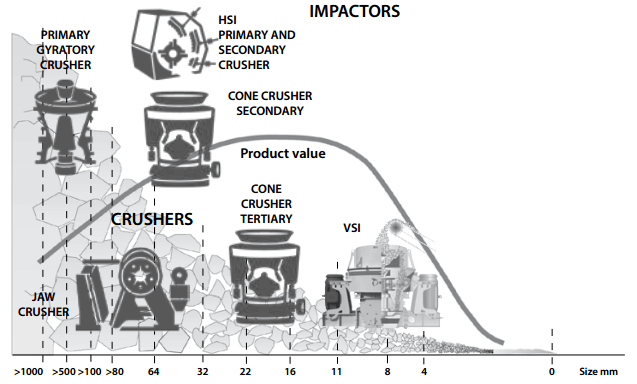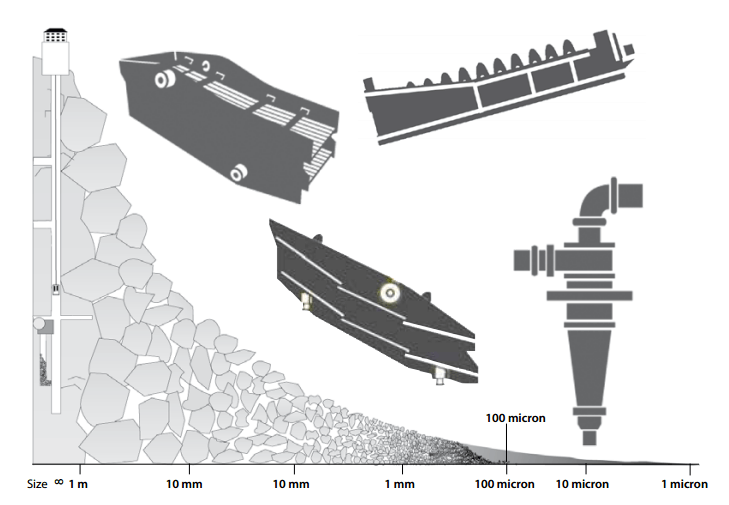Table of Contents
The term “primary crusher,” by definition, might embrace any type and size of crushing machine. The term implies that at least two stages of crushing are involved, but in many cases the machine which performs the function of initial crusher is the only crusher in the plant. The factors influencing the selection of a crusher for this service are much the same, regardless of how many crushing stages there are in the flowsheet; therefore, the term “primary crusher,” by common usage, is applied to the crusher which takes up the job of reduction where the blasting operations leave off.
Selecting the right type and size of primary crusher is a problem of prime importance in the designing of a crushing plant of any nature and size. Usually this machine is the largest and most expensive single item of equipment in the plant; a mistake in the choice can only be remedied fully by replacement; and, because the entire primary crusher-house arrangement is generally “tailored”.to fit the crusher, such .replacement is almost always a costly procedure. While personal favouritism toward some particular type of crusher may safely be allowed to swing a close decision, it should never blind the engineer or operator to the merits of other types, nor to the limitations of his favorite.
The following factors all have a more or less important bearing upon the choice of the primary crusher.
- Characteristics of the material.
- Average daily, or hourly, capacity required.
- Product size, or crusher discharge setting.
- Type and size of quarry equipment.
- Methods employed in drilling and blasting.
- Method of feeding the crusher.
The first three of these factors will almost always be ascertainable at least to a close approximation before the matter of crusher choice is taken up. Sometimes, as when a new crushing plant, or a new primary crusher set-up, is to be installed at an existing operation the last three factors will be pre-established. Otherwise, it is sound practice to consider them as a part of the problem of crusher selection. The primary crushing setup is closely linked to the quarrying or mining operation, and it is only by careful adjustment of all equipment selections to the general plan of operation that optimum operating results may be realized.
While it is convenient to discuss the influence of these several factors separately, it is well to keep in mind that they are more or less closely interlocked, and that a change in one of them may necessitate altering one or more of the others. In addition to the factors listed there are usually a few which are peculiar to each individual problem such as labor costs and so on. Any plant design problem is an economic as well as an engineering one. We are concerned here ,chiefly with the engineering phases.
Characteristics of Rocks to Crush
Characteristics of the material to be crushed include the geological classification of the rock, its physical structure, its chemical analysis (at least so far as abrasive constituents are concerned), and at least a qualitative evaluation of its resistance to crushing that is, whether soft, medium, hard, or very hard and tough. Frequently such information may be obtained from contiguous deposits which are being operated; sometimes the values must be arrived at by laboratory tests. It is never safe to make blanket assumptions, even on such a material as limestone, which can sometimes prove to be quite tough, as well as to contain significant amounts of abrasive silica.
Physical, or geological, structure of the deposit often has an important bearing upon selection of size or type, or both. If the deposit is thinly stratified, as, for example, many deposits of limestone are, it is safe to assume that the rock can be blasted economically into a condition for feeding a gyratory crusher of medium proportions, or, if other characteristics are suitable, a sledging roll crusher, such as the Fairmount machine. If, on the other hand, the formation is of massive character, again, some limestones are, the gyratory crusher might be ruled out in favour of the jaw crusher, unless the operation is of sufficient magnitude to warrant installation of a large size of gyratory. The proposed quarrying or mining procedure will of course have some bearing upon the size of rock to go to the crusher, regardless of its physical structure, as will be pointed out in further detail later on.
If the chemical analysis of the rock discloses that substantial amounts of free silica or any other abrasive are present, crushers of the sledging roll or hammermill types are usually ruled out unless the material is extremely soft and friable. There are occasional “speciality” applications where such machines may be indicated for crushing abrasive materials, but from the standpoint of, economical operation their use for such service is rarely justifiable.
The same restriction holds true for hard and tough materials. For such rock or ore our choice of a primary crusher is restricted to the gyratory and jaw types except, again, for the occasional “specialty” application where economy in maintenance may be sacrificed for other considerations such as lower first cost, or space restrictions.
Crusher Capacity Factor
The significance of this factor is so obvious that it sometimes does not receive quite as much thought as it should. From the standpoint of minimum requirement, it is of course closely tied up with product size, or crusher setting. But the primary crusher can seldom be chosen solely on the basis of capacity; it should never be selected with a view to just meeting the average capacity required to feed the rest of the crushing plant.
Just how much the rated capacity of the primary crusher (at the required discharge setting) should exceed the average capacity of the plant depends upon how uniformly the crusher will be fed; or to put it more definitely, what percentage of the total operating period the crusher will operate at full rated capacity. The answer to this is not always an easy one to predetermine, as it may depend upon several details of plant design and quarry operation.
In the average quarry operation, the only surge capacity between the quarry and the primary crusher consists of whatever quantity of rock may be, at the moment, loaded in cars or trucks, and usually this is not large. For that reason, any operating delays occurring in ‘ loading, transportation or primary crushing quickly affect all three of them, with the result that the feed to the balance of the crushing plant is cut-off until the trouble is rectified. If the plant as a whole is to maintain its rated average output, these departments must be capable of making up for such interruptions, and they can only do this if they have reserve capacity over and above the average requirement.
Such interruptions to continuous production are not uncommon in the primary crusher house; they may assume serious proportions if the crusher receiving opening is not large enough for the material it is expected to handle, and the largest crushers of any type will occasionally bridge or block.
Crusher capacity tables are predicated upon a continuous feed of rock of a size that will readily enter the crushing chamber; it is obvious therefore that a crusher whose rating just equals the average plant requirement would have no reserve to compensate for the conditions we have outlined. For the average quarry operation this reserve should be not less than 25 percent, and preferably about 50 percent.
Which Crusher is the Best Primary Rock Breaker
Since the minimum dimension of the feed opening of a crusher determines the maximum size of lump that it can take, the choice of a primary breaker is dependent as much on the size of the feed as on the hourly tonnage. Thus a 15 in. by 24 in. jaw crusher would be suitable for a small mine hoisting 300 tons in eight hours from underground workings from which lumps larger than 14 in. are not likely to be received. A crusher of these dimensions will break 40 tons per hour to 2½-in. size with a power consumption of 30 h.p. On the other hand, a 14-in. gyratory crusher, working as it should at full capacity, will crush 100 tons per hour to the same size with a power consumption of 70 h.p. ; at 40 tons per hour, it would still require about 50 h.p. The jaw crusher is evidently the more economical machine in this case, and its first cost is only about half that of the gyratory crusher.
If the capacity of the primary breaker is required to be 100 tons per hour or over, a gyratory crusher is likely to be more economical than the other type, since it costs no more than a jaw crusher of similar capacity and consumes less power. Moreover, the difference in power consumption between the two types of machine is greater in practice than in theory; this is due to the fact that, since the gyratory crusher can be choke-fed, it is easier to keep it running at maximum efficiency.
The position is different when mining is done by power-shovel. The maximum size of lump delivered to the crushing plant is much larger than from underground workings, and it is not advisable to use a bin for the storage of the ore on account of the difficulty of handling very large lumps through a bin gate. Consequently the ore is generally sent direct to a preliminary breaker which reduces it to a size suitable for feeding the normal primary breaker. The first machine is often of the jaw type, although this depends on the circumstances. Suppose, to take an instance, that the shovels were equipped with 3-yd. dippers and that 2,000 tons were being mined per day. A 48 in. by 60 in. jaw crusher is more than large enough to take the maximum size of lump that could get through the jaws of the dipper, and it would break the whole day’s output to 6-in. size in eight hours with a power consumption of under 200 h.p. On the other hand, a 42-in. gyratory crusher, which is the smallest that could be installed with safety, has a maximum capacity of over 5,000 tons in eight hours with a power consumption of about 275 h.p. The jaw breaker would therefore be the more economical machine. It could, if necessary, be installed near the scene of mining operations, and would be set to deliver a 6- or 8-in. product, which could be conveniently transported to the crushing section of the flotation plant where it would be fed through the coarse ore bin to the primary breaker in the ordinary way.
The choice of a primary breaker is an individual problem for every installation. The type of mining and the regularity, size, and rate at which the ore is delivered, are the main determining factors, but all local conditions should be taken into consideration before a decision is made.
https://www.metso.com/
